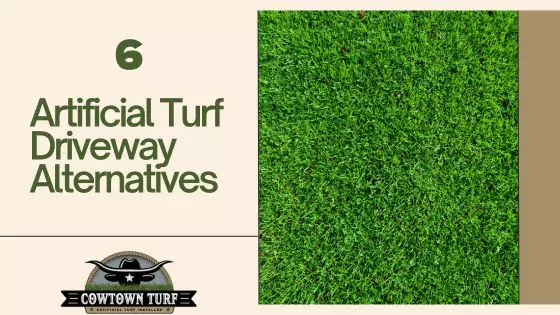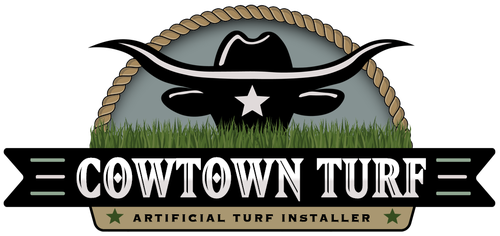Artificial turf or grass driveways won’t last long as they aren’t designed to withstand the weight of vehicles regularly.
While occasionally driving on synthetic grass or parking your vehicle for a few hours is unlikely to cause long-term damage, regular use of the turf as a driveway will quickly lead to its demise.
Luckily, several artificial turf driveway alternatives can capture the aesthetics without causing damage.

Why Synthetic Grass Highways Don’t Last
The average car weighs more than 4,000 pounds, roughly 22 times that of an adult male. So, while turf with a good “bounce back” can withstand kids and even adults running and playing sports, it’s not a match for a vehicle’s consistent weight.
In addition, rubber tires can damage some lower-quality artificial turf materials, further reducing their lifespan.
Turf is designed for recreational or decorative use, not for structural support. Even high-quality synthetic turf with robust infill systems and reinforced backings can’t withstand prolonged pressure from cars without matting, tearing, or sinking over time.
Furthermore, oil leaks, sharp turns, and tire friction can degrade the turf’s color, texture, and fibers, leading to unattractive bald patches and compromised integrity. Maintenance becomes both costly and frequent, undermining the low-maintenance appeal that draws many to artificial grass in the first place.
Artificial Grass Driveway Alternatives
While using artificial turf or grass as the foundation of your driveway (the part you drive over) is a bad idea, you can still incorporate synthetic turf into your driveway’s broader construction and aesthetic.
Check out some of the artificial grass driveway alternatives below:
1) Side Lawns
Surrounding your driveway with artificial turf side lawns fosters a magnificent curb appeal without compromising the turf.
Instead of subjugating the turf to wear and tear, you use it to accentuate the paved driveway and drive up your home’s value.
2) Greenery Wraps
Wrapping your driveway in greenery provides all the aesthetic appeal of a synthetic grass driveway without the wear and tear.
Consider enveloping your driveway with synthetic turf on both sides and ends, producing a year-round green color.
3) Turf Strips Between Pavers
Installing turf strips between pavers is another way to produce the aesthetics of an artificial turf driveway without damage.
Homeowners tend to avoid this setup with natural grass as it can become a maintenance and landscaping nightmare. However, the synthetic alternative eliminates these concerns.
4) Front-Yard Turf Segmenting
Homeowners can segment their outdoor space with artificial turf or grass through a garden hedge or small fence.
The goal is to separate the driveway and artificial grass without losing the aesthetic appeal of the visual combination. Adding flower beds, rocks, and plants can further enhance this setup.
5) Raised Turf Platforms or Inlays
Incorporating raised turf platforms or inset designs within your yard can simulate a multi-tiered landscape without inviting vehicle damage. These platforms can act as visual centerpieces or even functional elements like seating areas or planter stages.
Elevating the turf ensures no vehicle access, preserving the synthetic grass’s integrity while enhancing the overall layout.
6) Decorative Median Turf
A median strip made of artificial turf in the center of a dual-lane driveway can offer a striking visual feature. The turf doesn’t support direct vehicle traffic but enhances the driveway’s symmetry and curb appeal.
This setup is particularly elegant when paired with symmetrical lighting or brickwork, offering a balance of hardscape and greenscape.
Final Thoughts
Artificial grass can certainly be part of a driveway’s design—but not its structural foundation. By using creative landscaping techniques, homeowners can enjoy the benefits of synthetic turf without the premature wear that comes with parking and driving directly on it.
When planning your driveway, always prioritize function first. Once durability and performance are ensured through proper materials like concrete, pavers, or gravel, you can layer on aesthetic elements like artificial turf to boost your home’s curb appeal and make your space uniquely yours.

